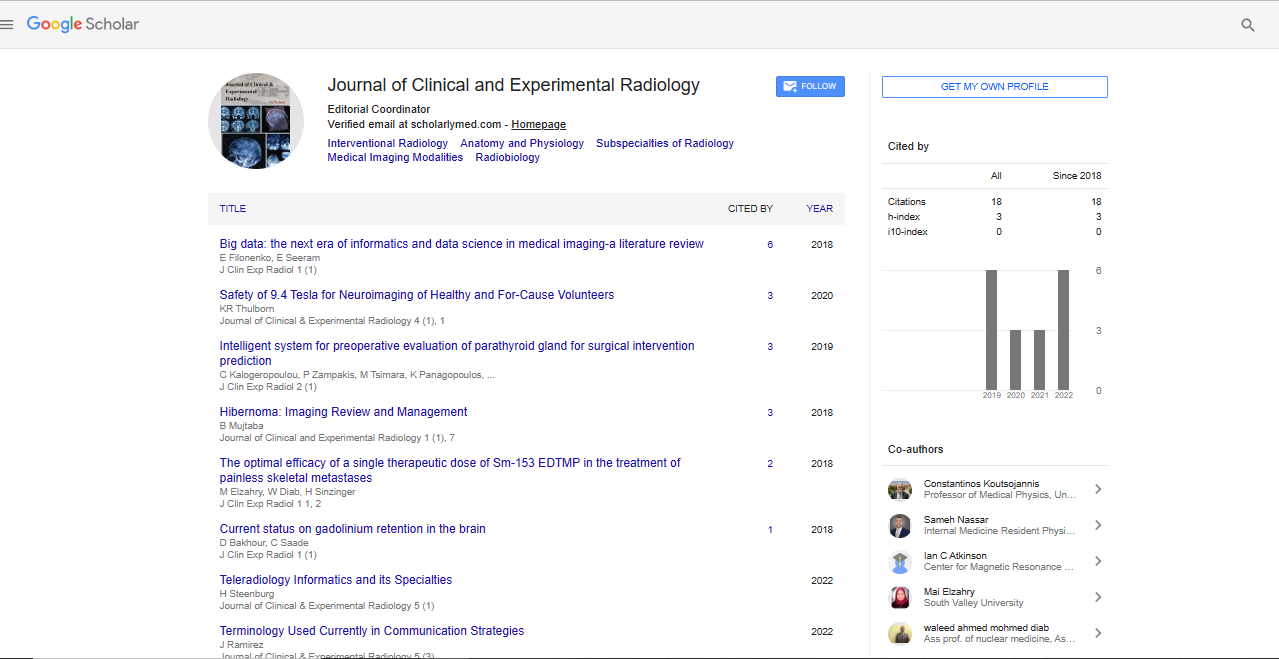Perspective, J Clin Exp Radiol Vol: 6 Issue: 1
Visualizing Biological Processes at the Molecular Level
Laura Bolzati*Department of Medical Imaging, University of Toronto, Toronto, Canada
*Corresponding Author: Laura Bolzati
Department of Medical Imaging, University
of Toronto
Toronto, Canada
E-mail: bolzatilaura@gmail.com
Received date: 20 February, 2023, Manuscript No. JCER-23-93119;
Editor assigned date: 22 February, 2023, PreQC No. JCER-23-93119 (PQ);
Reviewed date: 08 March, 2023, QC No. JCER-23-93119;
Revised date: 15 March, 2023, Manuscript No. JCER-23-93119 (R);
Published date: 22 March, 2023, DOI: 10.4172/jcer.1000122
Citation: Bolzati L (2023) Visualizing Biological Processes at the Molecular Level. J Clin Exp Radiol 6:1.
Description
Molecular imaging is a technique used to visualize and monitor biological processes at the cellular and molecular level. It is a rapidly growing field that combines advanced imaging technologies with molecular probes to study the behavior of molecules, cells, and tissues in vivo. This technique has many applications in basic research, drug development, and clinical practice.
The basic principle of molecular imaging is to use molecular probes to visualize and monitor biological processes. These probes can be divided into two main categories: endogenous and exogenous probes. Endogenous probes are naturally occurring molecules, such as proteins and metabolites, which can be labeled with a contrast agent for imaging purposes. Exogenous probes, on the other hand, are synthetic molecules that are designed to selectively bind to specific molecular targets, such as receptors or enzymes, in order to visualize or modulate their activity.
Molecular Imaging Modalities
There are several imaging modalities that can be used for molecular imaging, including Positron Emission Tomography (PET), Single- Photon Emission Computed Tomography (SPECT), Magnetic Resonance Imaging (MRI), Computed Tomography (CT), and optical imaging. Each modality has its own strengths and limitations, and the choice of modality depends on the biological process being studied and the specific molecular probe being used.
One of the most commonly used molecular imaging techniques is PET. PET uses radioactive isotopes, such as fluorine-18 or carbon-11, that are incorporated into molecular probes to visualize biological processes in vivo. The radioactive decay of the isotopes produces positrons, which interact with nearby electrons to produce photons that can be detected by a PET scanner. By measuring the distribution of radioactive probes in the body, PET can provide information on metabolic activity, receptor expression, and other molecular processes.
Molecular Probes and Imaging Technologies
Another commonly used molecular imaging technique is MRI. MRI uses strong magnetic fields and radio waves to produce highresolution images of the body. Molecular probes for MRI can be designed to alter the magnetic properties of tissues, allowing them to be visualized with greater sensitivity and specificity. For example, superparamagnetic iron oxide nanoparticles can be used as contrast agents for MRI to visualize the location and distribution of cells in vivo.
Optical imaging is another molecular imaging modality that is particularly well-suited for preclinical studies. Optical imaging uses light to visualize molecular processes in vivo, and can be used for a wide range of applications, including tumor imaging, gene expression imaging, and protein-protein interactions. Optical imaging can be performed using a variety of techniques, including fluorescence imaging, bioluminescence imaging, and photoacoustic imaging.
Molecular imaging has many applications in basic research. For example, it can be used to study the molecular mechanisms of disease, to monitor the efficacy of drug therapies, and to develop new therapeutic strategies. In drug development, molecular imaging can be used to screen candidate compounds for their ability to target specific molecular pathways or to monitor the biodistribution and pharmacokinetics of drugs in vivo.
In clinical practice, molecular imaging has many applications in disease diagnosis, treatment planning, and monitoring. For example, PET imaging can be used to diagnose cancer, to stage the disease, and to monitor response to treatment. MRI can be used to visualize the location and extent of neurological diseases, such as Alzheimer's disease, and to monitor the progression of the disease over time.
Molecular imaging is a powerful technique for visualizing and monitoring biological processes at the molecular and cellular level. It has many applications in basic research, drug development, and clinical practice, and is an essential tool for understanding the molecular mechanisms of disease and developing new therapeutic strategies. As molecular probes and imaging technologies continue to improve, molecular imaging is poised to play an increasingly important role in biomedical research and clinical practice.
 Spanish
Spanish  Chinese
Chinese  Russian
Russian  German
German  French
French  Japanese
Japanese  Portuguese
Portuguese  Hindi
Hindi 